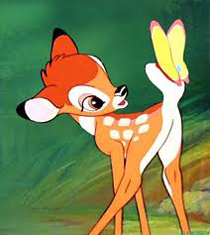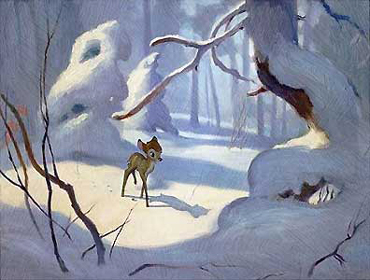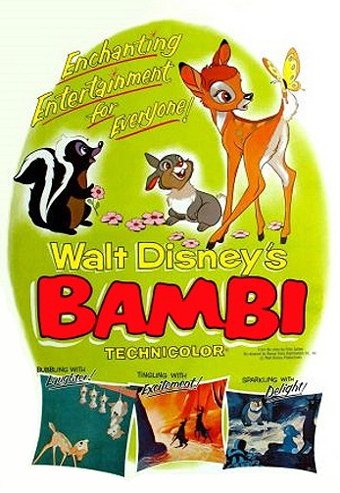
 |
|
|
|
One of Walt Disney's best animated features, Bambi transcends the genre of cartoons about cute forest animals. Taken from a serious novel about man's destructive role in nature's cycle of life, it is at once an enchanting film for children and a wondrous evocation of universal experiences: the miracle of birth, the wonder of childhood and youth, and the fearsome experience of the coming of age. Disney's beloved Bambi has been carefully remastered once again for Blu-ray. A couple of Disney's earlier releases "repainted" the studio's original animation but this carefully nuanced job retains minor artwork and camera imperfections that should remain part of the show. 2 Digital cleanup was fifty years away when this classic was made and the animation artists that put years of labor into Bambi created a hand-crafted piece of art that computers will never equal. The story plays out in several seasonal-themed episodes. The newborn fawn Bambi finds that all the animals are his friends, especially a rabbit named Thumper and a skunk he names Flower. When he's old enough to go to the meadow his mother must constantly be on the lookout for the dreaded intruder known as Man. Bambi meets and is perplexed by the young doe Faline. His first winter is a time of adolescent fun in the snow and on the frozen ice, but when Bambi becomes a yearling there are bitter life lessons to be learned. 
Felix Salten's book Bambi is a chastening experience and one of the world's first popular novels with an environmental theme. After reading it in junior high school I knew I'd never be a hunter. In the original book Bambi has an idealistic friend, a young deer that decides that because he'd once encountered some friendly humans, the idea that Man is dangerous is a myth. To prove his point the deer goes out into the clearing to greet some hunters and is promptly shot dead. Disney used every ounce of his production muscle and story smarts to retain the theme of Man as a menace to nature, without resorting to overly ironic violence or verbal lectures. The deer don't discuss Man, Man just is. The animals of the forest are admittedly a rather unrealistically cooperative lot -- that owl never picks off a baby bunny for lunch -- but none of them voices a philosophy beyond practical advice in the here and now, such as "Run!" Instead, the visuals carry almost everything and our own knowledge of the realities of life fills in the blanks. The story is reduced to a few simple scenes. The animals of the forest are transient beings. Just like humans, they're mostly unaware of the awesome grandeur around them. Disney's artists create a familiar forest world that is wondrously alive with leaves borne on the wind and winter's snows that carpet the ground. We experience it all along with the baby fawn Bambi, as if reliving our own childhoods. The wistful background artwork and the animation techniques for water, fire and other phenomena appear to be refinements gained from the experience of creating Fantasia. Although Disney may have run a labor-unfriendly shop, he concentrated a core of highly specialized talent and provided them with a continuity of superior projects. For fifteen years or so, every one of the Disney Studio's animated features seemed yet another miracle of imagination. One reason to question the universe of Disney's animated films is that his animals are given qualities that real animals don't have. The cute animated critters of Bambi are of course not realistic, but their similarities to humans enable possibilities of personal identification that don't exist with "human" characters -- which in drama are also artificial creations. The baby animals were partially modeled after human babies, creating a heightened adore-ability. We identify with Bambi and want to protect him because he's so vulnerable and because he's not ready to face the cruel world beyond his mother's protection. His best pal thumper has a full range of winning kid qualities: enthusiasm that gets him into trouble, spirit that wins him friends and a mischievous streak that's irresistible. These creatures embody the fragile innocence in life. Bambi also captures the magic of young love, knowingly acknowledging that among children, the girls are always more hip to what's happening. Faline is perhaps a little older than Bambi but probably not by much. I remember being impressed by fourth grade girls when they were sometimes right up front with their honest affection. I was too shy to respond but at least I wasn't a piece of wood like most boys my age. Bambi accomplishes the miracle of making us re-experience innocence (the little we were afforded) with a pleasant nostalgia. I wonder how many of those fourth grade Jezebels are now grandmothers? 
I remember hearing college students criticize Bambi along political lines, saying it reinforced a patriarchal society in which the silent, god-like Alpha-male buck lords it over a forest full of worshipful does. Maybe they have a point, but if we stick to the birds and the bees and the deer in the woods, Bambi isn't warping anybody's consciousness. In reality, the King of the Forest would be Bambi's paterfamilias and the mate for all the does, a rank won by intimidating all comers in combat. Fairness, equality and enlightenment are fine, but if we're to draw parallels with human behavior, it's easy to see that a goodly number of impressionable females still flock to a few desirable males, whether they be high school jocks or hotshots with a corner office. Bambi is also Disney's best movie about dealing with death. I remember hearing that a cousin ten years older than I was supposedly traumatized in the scene ... you can guess what happens, it's a famous scene. At this time ol' Walt was considerably gutsier than in his later years. The tough content in his movies would probably land him in hot water with child psychologists -- just let them loose on the implications of all of Disney's "rump humor" sometime. Dumbo pulls the heartstrings of mother love. Bambi tells the brutal truth with only the distance of a nature allegory to soften the blow. The cycles of birth, love, seasons and death in Bambi have an almost mystical feel helped by the reverential music score and its songs to the changes in nature. To be frank, the movie can help a young person understand that all of their confused feelings and experiences aren't necessarily unique, that at any given moment there are millions of people going through all of those universally experienced stages. To have a child and think only in terms of your own joy is one thing, but to become a parent and realize one is now part of an ageless race of creatures that experience love and innocence through their offspring, that's another thing entirely. Bambi has that kind of magic. nbsp;1 Disney's Blu-ray of Bambi may be the same carefully mastered transfer as seen on the 2004 DVD edition, but the added resolution and clarity make a big difference to the film's impact. The picture is brighter than ever and almost transparently beautiful. The digital cleanup has changed the film's look, but I have to say that I don't think that anyone would prefer the look of an old Technicolor print, which was designed for theatrical projection. Here, it is if the film's original cels and backgrounds had been digitally scanned and re-combined. We're more aware than ever that the background artwork has the look of watercolors or chalk drawings. If one concentrates too hard, the cel-animated creatures may appear to have less of a connection with the backgrounds. Has the look of Bambi been compromised? The way to compare is to check out the restored trailer included in the extras. It would seem to be sourced from a Technicolor print. It's much darker, and the colors are dull; various parts of the image clog together. Of course the characters seem more a part of the background, but they're practically mushed into it: I don't think anyone would prefer seeing Bambi looking like the trailer. 
The Blu-ray + DVD package spreads a lot of extras over a menu interface that can be quite a minefield of dead ends. A "recommended features" list on the first menu page merely pulls items from later in the menu choices. Sometimes it's difficult to back out of a selection once it's been chosen, and some menus have no 'exit back to the earlier level' option. Left-arrowing helped me out of one dead end. I guess I need one of Disney's preschool remote control commandos to solve these problems. The extras on the Blu-ray disc are divided into Family Play games and activities, including a "Disney's Big Book of Knowledge Bambi Edition" interactive book that talks about Bambi's lovable forest friends (no Screwy Squirrel here). Backstage Disney begins with a newly re-edited "Story Meeting" feature, which dramatizes the development of the project using actual Disney transcripts. Then come two Deleted Scenes and a Deleted Song, "Twitterpated". That's followed by a tall stack of Interactive Galleries. "Classic DVD" bonus features are presumably older standard def featurettes. The "Making of Bambi" introduces us to the child vocal talent used in the film and shows how nature and anatomy studies were used to give the forest animals a heightened realism. It meshes well with the anthropomorphosed eyes and facial expressions. Ever seen a real deer up close? They aren't very expressive. "Tricks of the Trade" is a demonstration of the mighty multi-plane camera. "Inside the Archives" is sort of an institutional piece about the company's new storage and research facility. The Old Mill is the award-winning 1937 animated short subject that saw Disney experimenting with stylized animation in Technicolor and multi-plane. And the original trailer is included as well. The feature can be seen with an introduction by Diane Disney Miller, and with or without "Disney View", an option that adds stylized sidebars to the 1:37 screen to fill out 16:9 widescreen TVs. Another "Disney Second Screen" option allows one to hook a computer up to the Blu-ray player for a screening accompanied by various visual extras and games. This seems like something planned to encourage ADD in young kids -- I should think that the best thing about showing your tot Bambi would be to teach the idea that concentrating on one "information stream" at a time can reap a special reward. The DVD disc repeats a few of the extras, and includes an older "DisneyPedia" feature about the real animals depicted in Bambi. It's a useful helper to let tots know that the wilderness isn't full of cuddly squeeze toys -- those suckers have ticks and lice, Cindy Lou, not to mention sharp teeth and hooves. It reminds me a bit of a hilarious "See and Say" Mattel toy commercial from the early 1980s. It explained that city kids had lost their country roots by showing a little boy pointing at a cow in a barnyard and happily saying, "Doggie!"
On a scale of Excellent, Good, Fair, and Poor, Footnotes:
1. Personal connections: Paul Satterfield and Norman Wright are on the Bambi credits as sequence directors. I learned to cut TV commercials with Norman's son Peter and met Norman on a number of occasions. When my UCLA student film needed an elaborate optical I took my cut negatives to Paul Satterfield, who in 1975 was running a little optical printer on Seward Street. Satterfield liked the idea that my student cameramen Clark Dugger and Hoyt Yeatman had shot the elements on a pin registered Mitchell camera. He did the job literally overnight, fixing an error in my counts and improving my simple concept. I remember that Satterfield charged me all of $60 and waved goodbye like I was a good boy going off to kindergarten. I didn't learn how notable he was until years later. My film was no classic but it got me my first job with Doug Trumbull's people. It's funny -- the associates you foolishly think owe you something, and the people who you know you owe plenty. Be nice to the next mixed up kid who walks in, as it's really you.
2. It's Snow White I'm talking about here ... either noise reduction or some kind of digital cleanup also removed brush strokes and evened out colors ... my opinion, and that of several others who saw it. We compared it to a laser disc. I personally haven't seen other discs that I've heard complaints about.
Reviews on the Savant main site have additional credits information and are often updated and annotated with reader input and graphics. Also, don't forget the 2010 Savant Wish List. T'was Ever Thus.
Review Staff | About DVD Talk | Newsletter Subscribe | Join DVD Talk Forum |
| ||||||||||||||||||